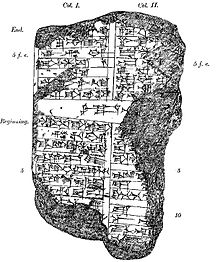Marduk-shapik-zeri
| Marduk-šāpik-zēri | |
|---|---|
| King of Babylon | |

Cylinder of Marduk-šāpik-zēri commemorating reconstruction of the Imgur-Enlil wall of Babylon.
|
|
| Reign | ca. 1082–1069 BC |
| Predecessor | Marduk-nadin-aḫḫē |
| Successor | Adad-apla-iddina |
| House | 2nd Dynasty of Isin |
Marduk-šāpik-zēri, inscribed in cuneiform dAMAR.UTU-DUB-NUMUN or phonetically -ša-pi-ik-ze-ri, and meaning “Marduk (is) the outpourer of seed”, ca. 1082–1069 BC, was the 7th king of the 2nd dynasty of Isin and 4th dynasty of Babylon and he ruled for 13 years. His relationship with his predecessor, Marduk-nādin-aḫḫē is uncertain. His reign overlapped that of the Assyrian king Aššur-bēl-kala and his immediate predecessor(s) as the Synchronistic King List places him alongside both Tukultī-apil-Ešarra and Aššur-bēl-kala.
He succeeded Marduk-nadin-aḫḫē, who may possibly have been his father or brother, during a time when the Arameans, driven by famine, were engaged in attacking the Assyrias under Tukultī-apil-Ešarra during his latter years, which Younger places in Tukultī-apil-Ešarra’s 32nd year, or 1081/80 BC. The events are recorded on a fragmentary chronicle. In a letter from the Babylonian astrologer Bel-ušezib to Esarhaddon, 681 – 669 BC, he wrote, “Bel has said: May Esarhaddon, king of Assyria, be seated on his throne like Marduk-šāpik-zēri! – I will deliver all the countries into his hands!” and this may suggest that he was a younger son of Nabû-kudurri-uṣur or there was perhaps a struggle over the succession.
He repaired the E-zida at Borsippa as witnessed by a building inscription, reproduced on a neo-Babylonian tablet, from the reign of Kandalanu whose colophon records that it was copied by Nabû-šumu-līšir. He provided gold votive offerings to the temples of Ur, Nippur and elsewhere. He rebuilt the wall of Babylon, the Imgur-Enlil, for which a fragmentary inscription has come to light, confirmed by the Eclectic Chronicle which continues,
He conquered the kings of the lands. During his reign, the people of the land enjoyed prosperity. He made an entente cordiale with Aššur-bêl-kala, king of Assyria. At that time, the king went from Assyria to Sippar.
...
Wikipedia
